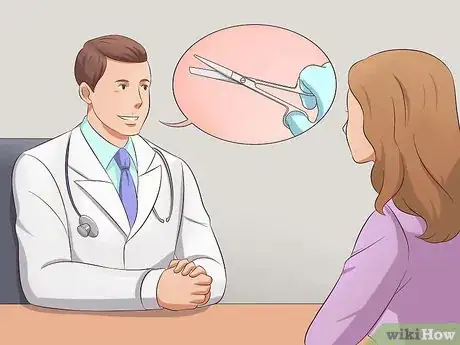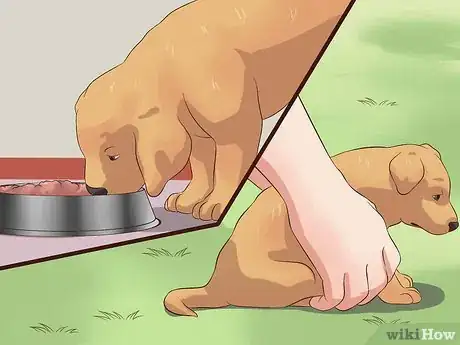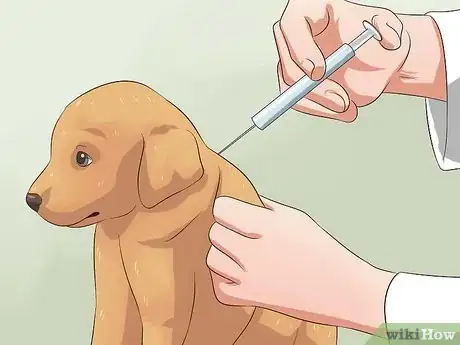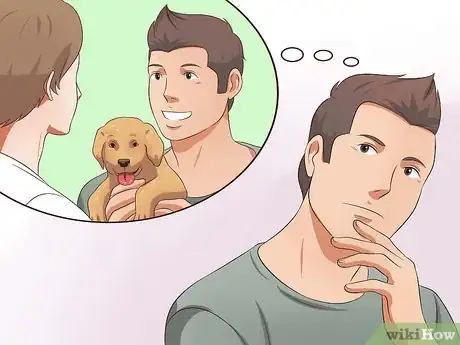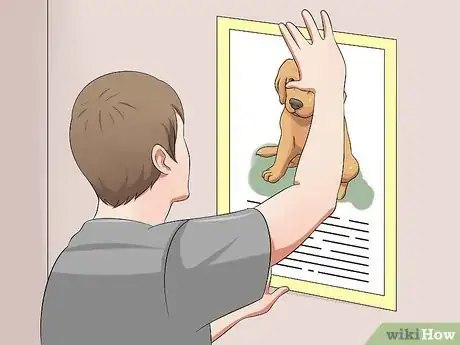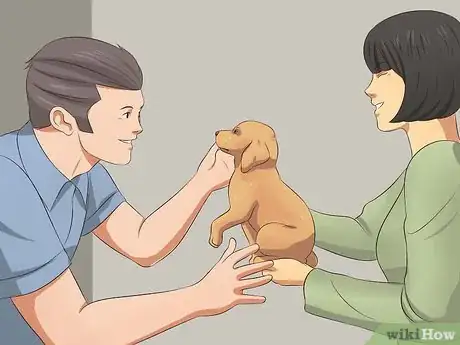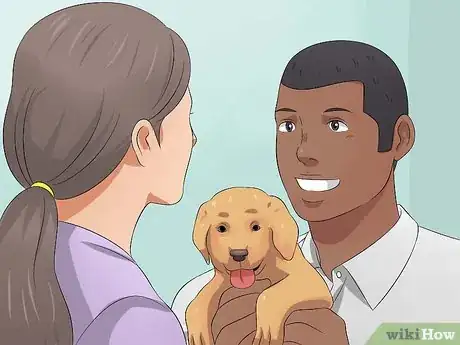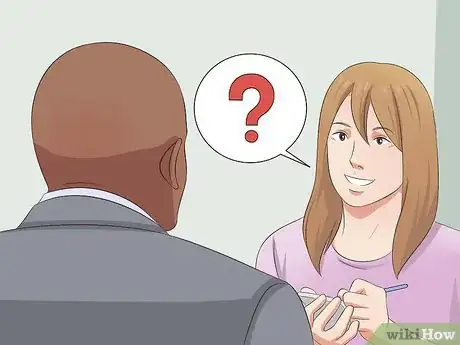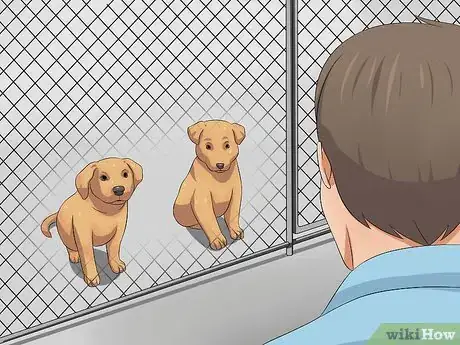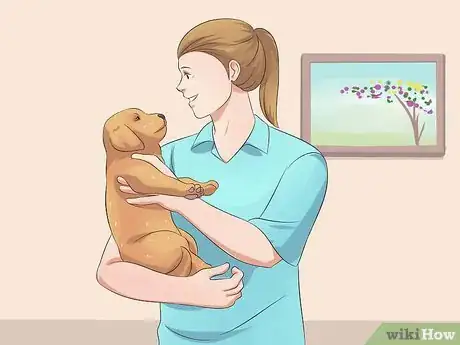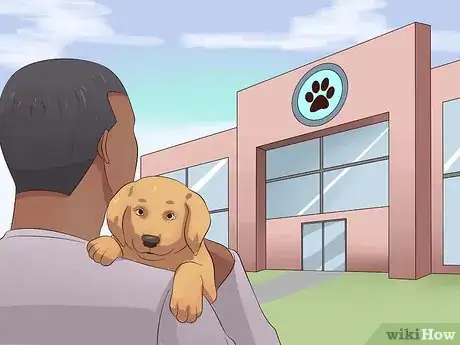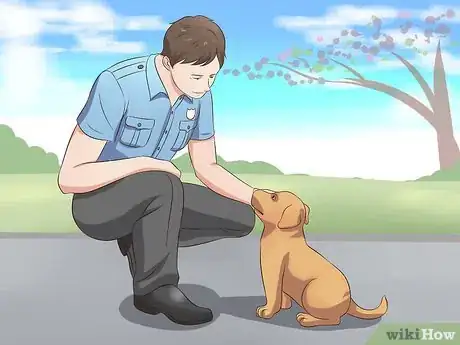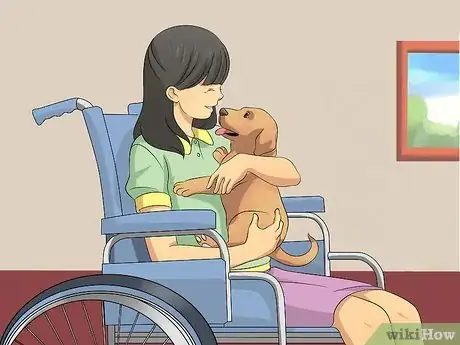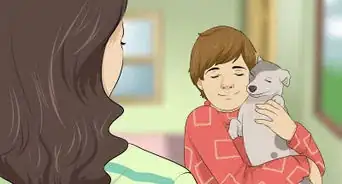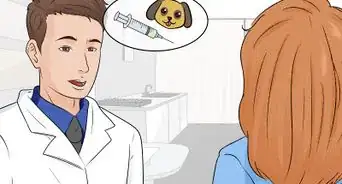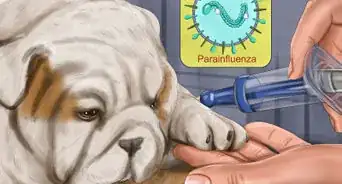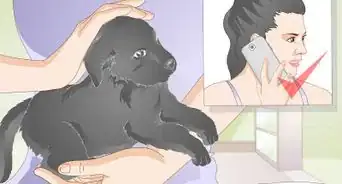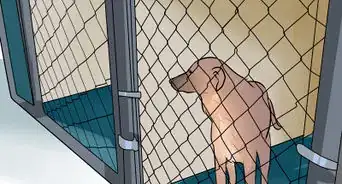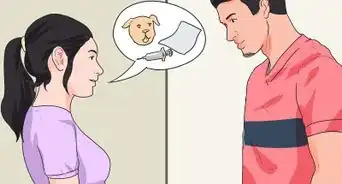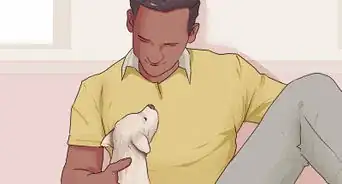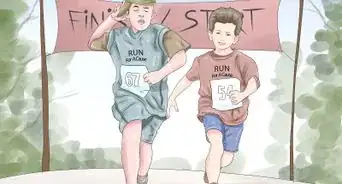wikiHow is a “wiki,” similar to Wikipedia, which means that many of our articles are co-written by multiple authors. To create this article, 9 people, some anonymous, worked to edit and improve it over time.
There are 14 references cited in this article, which can be found at the bottom of the page.
This article has been viewed 50,115 times.
Learn more...
You have a puppy you cannot keep. Perhaps your landlord doesn't allow pets, the financial burden is too great or you just don't have time to properly care for a puppy. Whether it is difficult emotionally for you or not, you need to make sure that the puppy winds up in a good home where it will be healthy and happy. Fortunately, there are many options for giving away a puppy.
Steps
Preparing for the Adoption
-
1Spay or neuter the puppy. Most new owners will want a spayed or neutered animal.[1]
- Low cost spay/neuter programs are available. Check with the ASPCA for a program in your area.[2]
- Most veterinarians recommend spaying or neutering at 6-9 months of age. However, the latest research suggests that the procedure can be done safely as early as 6-8 weeks.[3]
- Spaying and neutering helps reduce the number of unwanted pets and reduces the burden on shelters (and others) who house and find homes for unwanted pets.
- Spaying and neutering has been shown to reduce unwanted behaviors such as humping, roaming, aggression and urine marking.
- The health of the puppy will also be improved by spaying or neutering. The procedures have been shown to reduce certain kinds of cancers (breast, testicular) as well as uterine infections and perianal tumors.
-
2Housebreak the puppy. Teach him to only eliminate waste outdoors.
- Puppies can hold waste only the number of hours as his age in months. For example, a two month old puppy will need to go out every two hours.[4]
- Start housebreaking when the puppy is between 12 and 16 weeks old. At this point he should have enough control over his bladder to train successfully.[5]
- To begin, take the puppy out every hour and after feedings or naps. Get him used to the idea of going outside.
- Be consistent with feeding times and times that you take him outside. Consistency and a schedule will help him learn to only go outside.[6]
- Use praise whenever he eliminates outside. Let him know he has done a good thing.
- Watch for signs your puppy needs to go out such as pacing, whining or scratching the door. As soon as you see a sign, take the puppy out.
- Until your puppy has mastered going to the bathroom outside, confine him to a crate or room whenever he is left alone.
- If the puppy has an accident and you catch him in the act, clap once sharply enough to startle but not scare him. Take him outside immediately.
- If he has an accident but you don’t find it until later, do not punish him. He cannot connect a current punishment with a past accident.
- Be sure to clean up any accidents immediately with an enzyme cleaner designed for pet accidents. You do not want the puppy to be attracted to one spot for elimination purposes.[7]
- Do not use an ammonia-based cleaner as urine contains ammonia.
Advertisement -
3Vaccinate your puppy. Vaccinations will keep your puppy healthy.[8]
- Your veterinarian can help guide you about the vaccinations needed and when to vaccinate.
- 6 to 7 weeks of age: Administer first combination vaccine (Distemper, Hepatitis, Parvovirus, Parainfluenza, Corona virus).
- 9 weeks of age: Second combination vaccine.
- 12 weeks of age: Third combination injection. You may opt for a lyme vaccine inoculation at this time. The lyme vaccine is repeated two weeks later, then once a year.
- 16 weeks of age: Final combination vaccine.
- 12 to 16 weeks of age: Rabies vaccine. Check with your veterinarian and local laws as the timing of this vaccine varies.
-
4Make a list of good options for giving away the puppy. You shouldn't just randomly give the puppy away. You don't know if that random new owner will really care for the innocent puppy. Some options are:
- Family
- Friends
- Neighbors
- Coworkers
- Shelters
- Humane societies
- Rescue organizations
- Law enforcement
- Service organizations
-
5Create a "press kit" for the puppy. Include photos, a description and other pertinent information.
- Take good color photos of the puppy. Make sure the puppy's face is visible. Showing the puppy playing is good. Photos of the puppy getting into mischief (chewing on shoes, spilling their food bowl) may turn off potential owners.
- Write up a great description of the puppy. Describe how fun it is, what it's favorite activities are. Be upbeat and creative.
- Make sure to mention that it has been spayed or neutered, vaccinated and housebroken.
-
6Advertise your puppy. There are many options for advertising and you should use as many as possible.
- Find an adopter by putting up fliers and posters in veterinary offices, dog daycare and boarding facilities, dog parks, and pet grooming salons.
- Advertise in a local paper.
- Use social media. Advertise on your FaceBook, Twitter, Instagram or other social media platform.
Giving to Individuals
-
1Give to people you know. Family, friends, coworkers and neighbors are a great place to start when looking for a home for a pet.
- Email your contacts with photos of the puppy and a description.
- Be sure to tell them that the puppy has been spayed or neutered.
- Provide proof of vaccinations or any other veterinary service.
- Offer to give the new owner the puppy's toys, food bowls, bed and any other items you have purchased for it.
- Offer to take back the puppy if they change their mind.
- Before handing over the puppy – even to someone you know well – observe them interacting with the puppy. Do both seem relaxed and happy? Does the puppy like the new potential owner? The puppy and owner should be a good match for each other.
-
2Give to strangers. There are many people who want to adopt a puppy but you may need to look beyond your circle of friends or family.
- Take extra care when picking a stranger to adopt your puppy.
- Always let the person know you will take back the puppy if they change their mind or if things don't work out.
- Make sure to exchange contact information so that they can find you if there are any issues or questions after the adoption.
- Charge a fee. A small fee will deter some people who may have malicious intents. The person can make the check payable to a local shelter if you wish.[9]
- Introduce the puppy and potential new owner. Watch their interaction. Do they seem relaxed? Is the puppy fearful? If you see or feel like anything isn't quite right, trust your instinct and find another person to adopt the puppy.
-
3Interview potential adopters. Asking questions can help ensure that your puppy will be placed with someone who can care for him properly. Some questions to ask include:[10]
- Why do you want a puppy?
- Have you cared for a puppy or dog before?
- Who will care for the puppy while you are at work?
- Do you have any children?
- Do you rent or own and does your landlord allow pets? You may want to ask for a letter from the landlord confirming that pets are allowed.
- Do you have other pets and if so, what kind? Will they get along with the new puppy? You may want to have a home visit to see the interaction for yourself.
- Can you provide references attesting to your ability to care for a puppy?
Giving to Organizations
-
1Bring the puppy to a shelter. Shelters exist all over the country to take in unwanted pets.[11]
- Research different shelters in your area before handing over your puppy. Not all shelters are the same.
- Some have no-kill policies and but many euthanize animals after a certain period of time because they cannot house the large volume of animals that are left with them.
- Visit the shelters and choose one that is well-managed, clean and where the animals look happy and well cared for.
-
2Give the puppy to a humane society. Humane societies, unlike shelters, do not necessarily take all animals brought to them.[12]
- Some humane societies only take in as many animals as they can handle, so they do not euthanize.
- Others are “open-door” and take any pet, which means they may euthanize an animal after only a few days or weeks.
- Check the policy of the humane society before dropping off your puppy.
- As with shelters, only leave your puppy with a well-run and maintained humane society.
-
3Leave at a rescue organization. Many non-profit organizations, and some individuals, rescue pets.[13]
- Pets generally receive more one-on-one attention in these environments than in large city shelters, for example.
- Living conditions may be better – dogs may be able to play outdoors and not live in cages the majority of the time.
- Space can be limited, however, so your local rescue may not have room for your puppy.
- Rescue facilities vary widely in terms of care. Research carefully before leaving your puppy.
-
4Donate the puppy to law enforcement. Many law enforcement agencies use dogs.
- Only a few dogs are suitable for police work but your dog may be one of them.
- German Shepherds are most sought-after for police work.
- Be aware that there is a lengthy evaluation process before a dog will be adopted by law enforcement.
- Contact your local law enforcement agency to find out if they are taking puppies for training.
-
5Donate your puppy for service. Service dogs are in high demand to help disabled people, and those with other medical conditions, live more independent lives.[14]
- Not only will your puppy find a home, someone in need will get the dog they’ve been waiting for.
- Some organizations train dogs for specific populations, such as disabled veterans.
- Service dogs must pass a screening for health and temperament.
- There are a variety of service dog programs available, including ones that provide service dogs globally.
Community Q&A
-
QuestionWhy do shelters kill the pets after a certain age? That is such a bad idea.
 Community AnswerIt is terrible, and nobody likes it, but it is because most shelters have a limited amount of space and resources. If an animal does not seem likely to get adopted, the resources have to be allotted elsewhere and the animal put down. Fortunately many shelters are no-kill nowadays. The best thing you can do to help is donate money to animal shelters and adopt from them, never from a breeder. Encourage everyone you know to do the same.
Community AnswerIt is terrible, and nobody likes it, but it is because most shelters have a limited amount of space and resources. If an animal does not seem likely to get adopted, the resources have to be allotted elsewhere and the animal put down. Fortunately many shelters are no-kill nowadays. The best thing you can do to help is donate money to animal shelters and adopt from them, never from a breeder. Encourage everyone you know to do the same. -
QuestionI don't want to give up my dog. It's actually my stepdad's dog, but he is giving it up because it cries and it's scared of him. What do I do?
 Community AnswerBring up the fact that since the puppy is young, it's still new to the world and is still exploring things and figuring things out. When you're new to the world, everything is scary. The dog's behavior is completely normal. Tell your stepdad to give the puppy treats and work on slowly getting closer to him/her. If the puppy cries at night, you might want to consider keeping him/her in a crate. Many dogs find it comforting to be in an enclosed space. Tell your stepdad to try to be patient, the puppy will adjust, it just needs some time.
Community AnswerBring up the fact that since the puppy is young, it's still new to the world and is still exploring things and figuring things out. When you're new to the world, everything is scary. The dog's behavior is completely normal. Tell your stepdad to give the puppy treats and work on slowly getting closer to him/her. If the puppy cries at night, you might want to consider keeping him/her in a crate. Many dogs find it comforting to be in an enclosed space. Tell your stepdad to try to be patient, the puppy will adjust, it just needs some time.
Warnings
- If you see signs of neglect or abuse, report the organization or individual to law enforcement.⧼thumbs_response⧽
- Do not leave your puppy anywhere or with anyone you do not fully trust.⧼thumbs_response⧽
References
- ↑ https://www.aspca.org/pet-care/top-10-reasons-spay-or-neuter-your-pet
- ↑ http://www.aspca.org/pet-care/spayneuter
- ↑ http://www.petmd.com/dog/care/evr_determining_best_age_to_spay_or_neuter
- ↑ https://www.aspca.org/pet-care/virtual-pet-behaviorist/dog-behavior/house-training-your-puppy
- ↑ http://pets.webmd.com/dogs/guide/house-training-your-puppy
- ↑ http://www.perfectpaws.com/htrp.html#.VTf6GSFViko
- ↑ http://www.humanesociety.org/animals/resources/tips/removing_pet_stains_odors.html
- ↑ http://www.petmd.com/dog/puppycenter/health/evr_vaccines_and_your_puppy
- ↑ https://www.aspca.org/pet-care/virtual-pet-behaviorist/dog-behavior/re-homing-your-dog
- ↑ http://www.humanesociety.org/issues/adopt/tips/adoption_process_what_expect.html
- ↑ http://www.peta.org/issues/companion-animal-issues/animal-shelters/
- ↑ http://www.humanesociety.org/work/?credit=web_id93480558
- ↑ http://www.adoptapet.com/blog/shelter-spca-humane-society-or-rescue/
- ↑ http://medicalservicedogs.com/what-are-service-dogs/
